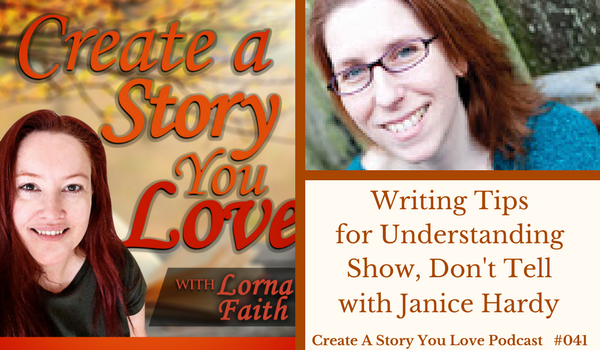To write unputdownable fiction, it’s important to understand how to craft your stories in a way that grabs readers attention.
One of the ways to do that is to learn to understand Show, Don’t Tell.

In this interview, award winning Fantasy author Janice Hardy, shares her tips. In the intro, I mention the breakthrough I had in my own writing, after an interview I had with Scott King. He offered to help me with my story deep and his insightful questions were super helpful.
I also talk about great books and resources that I’ve found helpful in the past couple of weeks, like Janice Hardy’s book Show Don’t Tell(And Really Getting It). Also, I’ve been learning how to really show up and be more present and engaging everyday, thanks in part to reading Brendon Burchard’s book, The Motivation Manifesto. Please share what you’ve been learning in the comments below, it would be great to learn from each other 😉
Click Here to Watch the Video Interview

Janice Hardy is the Award winning author of The Healing Wars Trilogy, including The Shifter (which was a 2014 list of Ten books All You Georgians Should Read, shortlisted for the Waterstones Children’s Book prize and the Truman Award) and Blue Fire and Darkfall.
She’s also the founder of Fiction University, a website dedicated to help writers improve their craft. Janice’s popular Foundations of Fiction series include: Planning Your Novel; and Revising Your Novel and the First book in her Skill Builders series: Understanding Show Don’t Tell(And Really Getting it).
Highlights of the Interview:
- Janice shares how she started writing Fantasy and Science Fiction, because it’s what she liked to read.
- She started blogging about writing when her first book came out in 2009. As her audience started to ask more questions on writing and craft she began FictionUniveristy.com.
- On Understanding Show Don’t Tell: You’re telling when you start explaining things, showing is all about dramatizing your story.
- Why it’s important to change up the dialogue and include some small action the character is doing.
- Janice talks about her Show Don’t Tell Writing Workshops where she invites people in the audience to give examples of: “She walked cautiously across the floor” or “He said angrily”. She says people give their interpretation of it, but she reminds her audience that you can’t act out motive. If you can physically at out what you’re trying to do, that’s showing.
- But, sometimes telling is necessary and the most effective way to get across what you want to say. She enc
ourages authors to really be solid with your character POV – that as the author you know how they think; how they judge the world around them; what they notice; why they notice what they notice; how they react to things -then you can put it in your character’s words and her voice. This makes all the difference to a great story and draws the reader in.
- A good rule of thumb to decide whether to show or tell that scene, is to ask yourself how important is this information to the story? The more important the information is to the story, the greater chance you should be showing it.
- When in doubt, think of your reader. Readers come for the plot and stay for the characters. They want to see the characters experience things. Readers are compelled by these characters and something makes them want to see how this turns out for them. When you are telling a good story, readers lose themselves in your book.
You can find some common red flag words that will indicate you’re telling, in the back of Janice’s book. This is useful to use as you go through the editing stage especially 🙂
You can connect with Janice on her website or on Facebook or Twitter.


